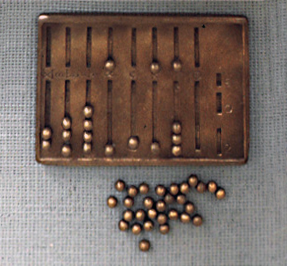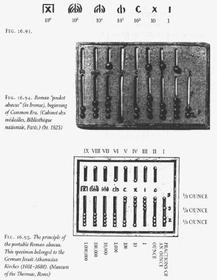by Steve Stephenson
In the history of mathematics, the contributions of the Roman Empire are sometimes overlooked. Roman Numerals are considered cumbersome and the Roman's lack of contributions to mathematics, and the lack of the Zero, are held in low esteem.
And yet, the Roman Empire was likely the largest when viewed as a percent of world population. Their empire consistently built engineering marvels: roads that survive and are used to this day, homes and bath houses with indirect heating emulated today, plumbed sewer and water lines in and out of homes and public buildings, indoor toilets, aquaducts that included long tunnels and bridges, and huge, beautiful buildings. Their engineers and architects designed and built these using counting boards and hand abaci; using Roman Numerals only to record the results.

Roman Hand-Abacus
The longevity of their empire was due to their commercial trade-- they were businessmen. The intricate, complex, and extensive accounting of their trade was conducted with counting boards and hand-abaci; again using Roman Numerals only to record the results.
And as anyone knows who has used a counting board or abacus, your rows or columns often represent nothing, or zero. Since the Romans used Roman Numerals to record results, and since Roman Numerals were positively definitive, there was no need for a zero notation. But the Romans certainly knew the concept of zero occuring in any place value, row or column.
One could also infer that they were aware of the concept of a negative number. How else would Roman merchants understand and manipulate liabilities against assets and loans versus investments?
The Romans developed their hand-abacus as a portable counting board-- the first portable calculating device for both engineers and businessmen.
Layout of the Roman hand-abacus
Here's the London Science Museum's Roman hand-abacus layout, where the ~3 was actually a symbol that looked like a 3 that was flattened on the top then flipped top to bottom and right to left, or rotated 180 degrees:
| | | | | | | | | | | | | | | |
| | | | | | | | | | | | | | | |
|*| |*| |*| |*| |*| |*| |*| |*|
___
|X| (((|))) ((|)) (|) C X I 0 ~3
| | | | | | | | | | | | | | | | | |
| | | | | | | | | | | | | | | | | | )
|*| |*| |*| |*| |*| |*| |*| |*| | |
|*| |*| |*| |*| |*| |*| |*| |*| | |
|*| |*| |*| |*| |*| |*| |*| |*| | |
|*| |*| |*| |*| |*| |*| |*| |*| |*| 2
|*| |*|

Roman "pocket abacus": (in bronze), beginning of Common Era (Cabinet des Médailles, Bibliothèque nationale, Paris). Note that fig. 16.94 has beads missing from most of the slots. The drawing on the bottom has incorrectly labeled the right-most slot. This abacus is similar to the one being described in this article. Image and caption from, The Universal History of Numbers, Georges Ifrah, Wiley Press 2000. (Click to enlarge.)
The abacus was made of a metal plate where the beads ran in slots. The size was such that the abacus could fit in a modern shirt pocket. The upper slots contained a single bead while the lower slots contained 4 beads, the only exceptions being the two right-most columns, marked 0 and ~3.
Note the longer slots below the 0 and ~3 positions, the 5 beads in the lower slot of the 0 position, the 2 beads in the lower slot of the ~3 position, and the absence of an upper slot in the ~3 position. I wonder what the ')' and '2' symbols along the right side of the ~3 slot meant?
Obviously the units in the 0 position were 1/12 of the I position, and the units in the ~3 position were 1/3 of the 0 position. So the upside down reversed 3 character seems appropriate to represent 1/3; or, more likely, our symbol for 3 came from the Roman symbol for 1/3.
It is also worth noting that:
- the Roman hand-abacus predates the Chinese "invention" of the Suan Pan;
- the Romans traded with the Chinese over the Silk Road (did the Chinese copy the Romans' hand-abacus?);
- the Roman hand-abacus has the refinements attributed to the modern Japanese Soroban; i.e. one bead above and four beads below the bar (did the Japanese copy the Romans' hand-abacus instead of the Chinese Suan Pan?); and
- the Roman hand-abacus incorporates mixed base arithmetic (in the two rightmost columns), another original enhancement by the Romans that is not present in any other abacus.
More information and conjectures on counting boards and Roman Hand Abaci can be found on Mr. Stephenson's web site.
A Possible Time Abacus
The last point, above, might lead one to develop a Time abacus1.
|*| |*| |*|
|*| |*| |*| |*| |*| |*| |*|
| | | | | | | | | | | | | |
| | | | | | | | | | | | | |
y q w d 6h h 6m m 6s s s/10
| | | | | | | | | | | | | | | | | | | | | |
| | | | | | | | | | | | | | | | | | | | | |
|*| |*| |*| |*| |*| |*| |*| |*| |*| |*| |*|
|*| |*| |*| |*| |*| |*| |*| |*|
|*| |*| |*| |*| |*| |*| |*| |*|
|*| |*| |*| |*| |*| |*|
|*| |*|
|*| |*|
|*|
|*|
|*|
|*|
|*|
|*|
| Column | Description | Base |
|---|---|---|
| y | year | 10 |
| q | quarter | 4 |
| w | week | 13 |
| d | day | 7 |
| 6h | six hours = 1/4 day | 4 |
| h | hour | 6 |
| 6m | six minutes = 1/10 hour | 10 |
| m | minute | 6 |
| 6s | six seconds = 1/10 minute | 10 |
| s | second | 6 |
| s/10 | 1/10 second | 10 |